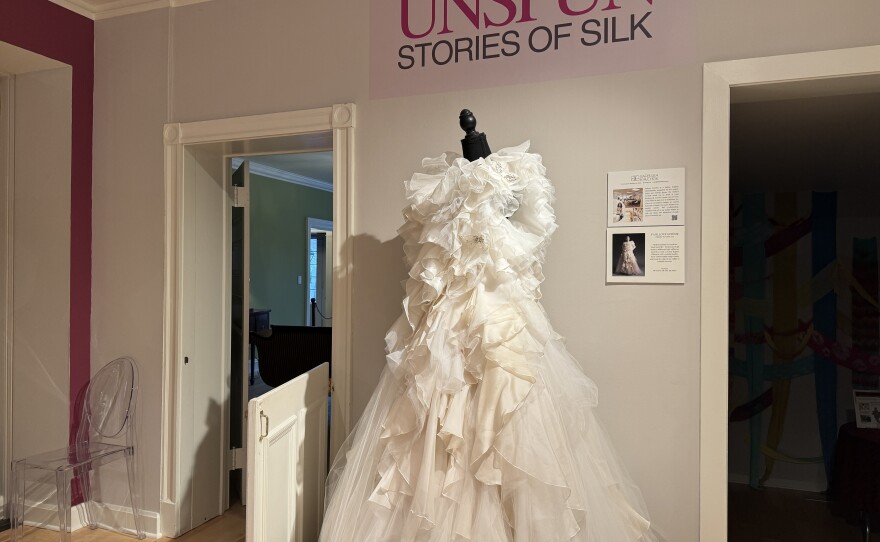BETHLEHEM, Pa. — Nestled amidst the historical streets of Bethlehem, a captivating story unfolds, as smoothly as silk.
“Unspun: Stories of Silk,” which runs through April 28, explores the Lehigh Valley’s Moravian connection to silk production.
The silk exhibition, which opened last June and unfolds across three museums, highlights silk’s intricate past.
“Unspun: Stories of Silk” is open through Sunday, April 28.Kemerer Museum
Starting at the Moravian Museum of Bethlehem, 66 W. Church St., visitors can learn about the history of silk production in the world and in Bethlehem.
At the National Museum of Industrial History, 602 E. 2nd St., they can learn about silk-producing machinery and the people who operated them.
At the Kemerer Museum of Decorative Arts, 427 N. New St., there is clothing, housewares and even wartime parachutes made of silk.
A wide range of silk objects include items as diverse as piano shawls, parachutes, puppets, maps and dresses.
The dresses on display at the Kemerer range from the 1870s to present-day, Brett Peters, curator of collections and exhibitions at the Kemerer Museum said.
There’s a variety of styles, colors and materials as it relates to silk.
Tickets, which grant access to all three venues, are $30 for ages 19 and older, $22 for ages 7-18 and free for ages 6 and younger, as well as for members of Historic Bethlehem Museums & Sites or the National Museum of Industrial History.
They're available on the Historic Bethlehem website.
Wedded in a parachute
One of the more unusual clothing pieces found in the museum is a silk wedding gown made from a World War II parachute.
The dress originally was worn by Delores Barthold, a local woman who was a second lieutenant and battlefield nurse in WWII, Peters said.
She was given the parachute by her boyfriend, who was an aviator, and created a wedding dress out of the silk material.
“When an amazing item meets a need for an exhibition, we are absolutely thrilled.”Brett Peters, curator of collections and exhibitions at Kemerer Museum
The bride passed away at the age of 101. Her daughter, Brenda Rinker, donated the dress to the Kemerer Museum.
Next to the wedding dress there is a silk parachute on display, loaned by a collector based out of Kutztown.
“It’s made of unbleached silk…which is what paratroopers and aviators used to glide harmlessly out of planes,” Peters said.
While all three museums have large historical collections, Peters said the Kemerer Museum always is looking for additions from the public, whether it be on loan or by donation.
“When an amazing item meets a need for an exhibition,” Peters said, “we are absolutely thrilled.”
Peters said the Kemerer has received a positive response from the public, which led to the decision to extend the exhibition’s end date from January to April.
Slipping through time in silk
Inside the museum, you’re transported back in time, where the beginnings of silk production in the Lehigh Valley take center stage.
Silk was first produced in Bethlehem by a member of the Moravian clergy in 1752, Peters said.
On April 28, The Kemerer Museum’s new gift shop will be unveiled at its “April in Paris” event from 11 a.m. to 4 p.m.Kemerer Museum
Initially, the clergyman experimented with wild silkworms and red mulberry trees, but eventually switched over to domesticated silkworms and white mulberry trees.
The production of raw silk in the Lehigh Valley halted in the 1840s, Peters said.
“It’s a really incredible controversy that you’ll have to learn about at the Moravian Museum of Bethlehem,” he said.
But by the 1900s, when sellers began to import raw silk rather than producing it themselves, the Lehigh Valley became a center of silk production.
Also on April 28, The Kemerer Museum’s new gift shop will be unveiled at its “April in Paris” event from 11 a.m. to 4 p.m.
The event will showcase Parisian items for sale along with Chanel pieces loaned by a local collector, Peters said. Guests can enjoy drinks, music, and shopping while taking one last walk around the silk exhibition.









